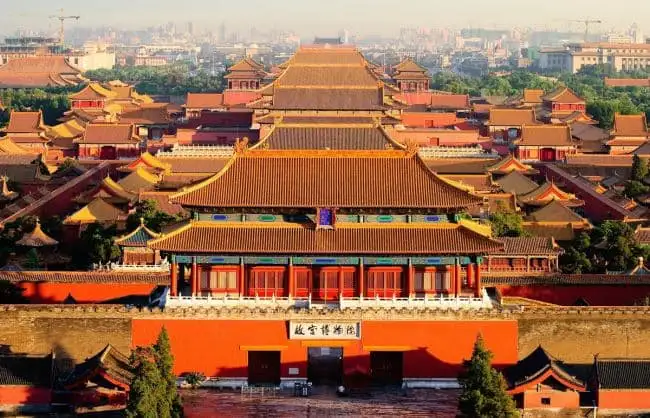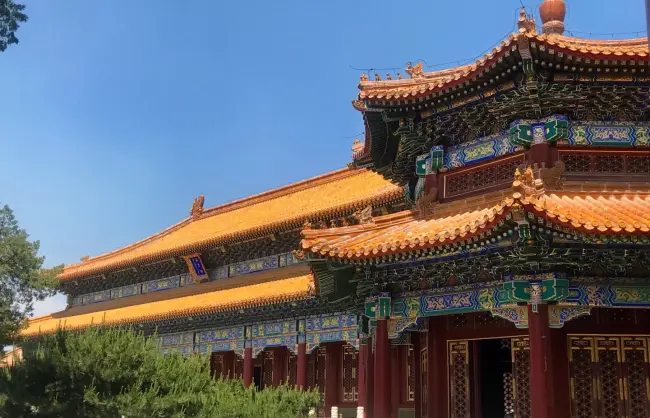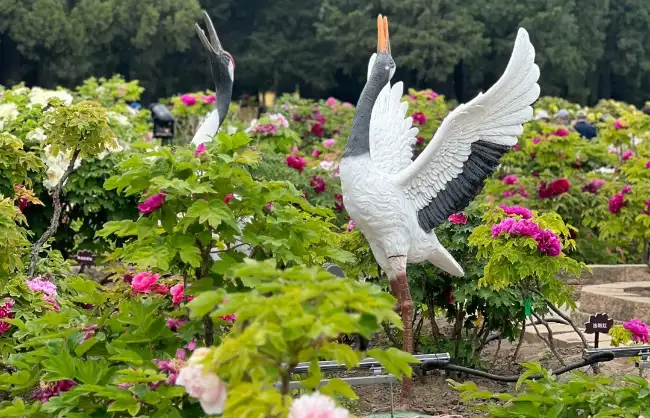On July 27, 2024, Jingshan Park and 14 other heritage elements along the Beijing Central Axis, which runs through the old city of Beijing from north to south, were inscribed on the World Heritage List.
Located at the center of Beijing’s southern Central Axis, Jingshan Park is adjacent to the Forbidden City to the south and Beihai Park to the west and faces the Drum Tower from a distance to the north. It was once the highest point in the center of Beijing, and served as the imperial garden for the Yuan, Ming and Qing Dynasties. Qingshan, Wansui Mountain, Zhenshan, Jingshan, and Coal Hill are all its formerly used names.
As one of the highest points in Beijing, Jingshan Park offers a spectacular vantage point for a breathtaking panoramic view of the Forbidden City. The dense ancient trees, unique peaks, majestic architectural complexes, and various peony species also make the park a culture- and nature-rich attraction in Beijing.

Fast Facts about Jingshan Park
- Chinese name: 景山公园(Jĭngshān Gōngyuán)
- Location: No.44 Jingshan West Street, Xichengcheng District, Beijing, China
- Area: About 23 hectares
- Opening hours: 6:30 to 21:00 from Apr. – Oct.; 6:30 to 20:00 from Nov. – Mar.
- Visiting time needed: 1-2 hours
- Entrance fee: CNY 2 per person; When certain activities or cultural festivals are held, the ticket is CNY 10 per person.
- Best time to visit: Suitable to visit in all seasons, spring and autumn are especially recommended.
- Highlights: Rich history, ancient buildings, cultural relics, frequent cultural activities, and various peony species.
Why Visit Jingshan Park
Now, most tourists add Jingshan Park to their Beijing Tours to enjoy the best panoramic view of the Forbidden City. But, the park is also celebrated for its exquisite garden design, natural beauty, and rich historical heritage. With a history of nearly one thousand years, Jingshan Park retains architectural marvels from different dynasties, including the mountains from the Liao Dynasty, the walls and gates from the Jin Dynasty, and architectural complexes from the Yuan, Ming, and Qing Dynasties. Among them, the impressive Shouhuang Hall Complex stands as the second largest architectural complex on Beijing Central Axis, second only to the Forbidden City.
What to See and Experience in Jingshan Park
Apart of the commanding view of the Forbidden City and the entire axis of the city, Jingshan Park also offers numerous historical relics such as the Shouhuang Hall, Guande Hall, Huguozhongyi Temple, and Qi Wang Tower. It was once an important site for ancestral worship and remembrance.
Admire the Full View of the Forbidden City and Beijing Central Axis
Add Jingshan Park to your Beijing tour if you want to experience the Forbidden City from a different perspective. The park features a ridge with five peaks, and each of them is topped with a pavilion. Among these pavilions, Wanchun Pavilion stands as the highest point of the park and the highest point on Beijing Central Axis, making it the top choice for visitors to catch the panoramic view of the Forbidden City and Beijing cityscape.
Standing on Wanchun Pavilion, you can admire the entire palace unfolding before you. The intricate layout, golden-glazed roofs and red walls of the palaces and its central axis from the Meridian Gate to the Shenyang Gate can all be clearly visible from this vantage point. This elevated perspective uniquely showcases the scale and grandeur of the Forbidden City. Also, this point highlights the striking contrast between the grandiose Forbidden City and the distant modern landmarks
Good to know: As Wanchun Pavilion is more and more popular. If you want to enjoy the view with less disturbs, Fulan Pavilion and Jifang Pavilion should be great alternatives.
Shouhuang Hall Complex (寿皇殿)
The impressive Shouhuang Hall Complex in Jingshan Park stands as the second largest architectural complex on Beijing Central Axis, second only to the Forbidden City. Originally built during the Ming Dynasty and rebuilt during the Qianlong period in the Qing Dynasty, Shouhuangdian was designed following the regulations of the typical Imperial Ancestral Temple. It is the place where the deities of all Qing Dynasty emperors were honored, showcasing the sacrificial culture, royal rites, and ancestral reverence of the Chinese nation. The many relics here, such as the stone lions at the entrance, the bronze deer and cranes on the pedestal, the yellow glazed tile roof of the well pavilion, and the ancient well all stand as silent witnesses to history.

Huai Zhong Huai (Huai Tree within a Huai Tree 槐中槐)
This remarkable Tanghuai (a type of Sophora tree) is recognized as the oldest ancient tree in the park, which is at least a thousand years old. The Sophora tree is about 20 meters in height, with a trunk diameter of 2 meters and a circumference of over 6 meters. Though the tree stands tall and majestic, with branches extending gracefully, its main trunk has been hollowed out. Intriguingly, within the hollow trunk, a small tree has sprouted, creating a unique phenomenon and adding a touch of magic to the ancient landscape of the park.
Five Pavilions on the Hill (五方亭)
Elegantly aligned on the five peaks of Jingshan Hill are five exquisite pavilions. From east to west, they are the Guan Miao Pavilion, Zhou Shang Pavilion, Wanchun Pavilion, Fulan Pavilion, and Jifang Pavilion. As the aesthetic highlights of Jingshan Park, these pavilions offer a glimpse into a variety of architectural styles and designs in ancient China. As mentioned above, the Wanchun Pavilion on the main peak is the best spot to enjoy the full view of the Forbidden City, while the four other pavilions also provide unique perspectives of the stunning surroundings, each adding to the rich visual experience of the park.
Qiwang Tower (绮望楼)
Qiwang Tower was initially established during the Ming Dynasty, serving as a space for royal family members to enjoy elevated views and leisure activities. During the Qing Dynasty, the tower underwent several renovations, which further refined and enriched it, making it a quintessential example of classical Chinese pavilion architecture. The tower has 5 stories, with each level featuring upward-curving eaves and ridges being adorned with intricate motifs such as dragons and phoenixes.
Enjoy Various Colorful Peonies
The history of peony cultivation in Jingshan Park can be traced back to the Jin Dynasty. And the large-scale peony planting in the park began in the Yuan Dynasty. By the end of 2014, the park boasts 515 varieties and 20,000 peony plants, featuring various color systems and flower types. Besides the varieties cultivated by Jingshan Park itself, visitors can also admire the famous Luoyang and Heze peonies, rare Paeonia rockii and many other foreign species.

When is the Best Time to Visit Jingshan Park
The Jingshan Park is a popular tourist attraction with different charming scenery all year round. Spring and autumn are especially recommended as these periods coexist with the best time to travel to Beijing, and will reward you with blooming flowers and crisp and clear air separately.
Tips: Visitors had better avoid the official holidays in China, because many Chinese citizens choose to travel on official holidays. As a result, most Chinese tourist attractions are overcrowded and traffic jams are quite common.
| Chinese New Year | Around January or February |
| Winter vacation | January-February |
| Labor Day | May1st -3rd |
| Summer vacation(for students) | July-August31st |
| Mid-Autumn Festival | Around mid-September |
| National Day | October 1st-7th |
How to Get to Jingshan Park?
- If enter throughthe the east gate,you can take bus No. 111 and No. 124 and get off the bus at Jingshan East Gate Station.
- If enter through the west gate, take bus No. 5 and No. 609, and get off the bus at Xiban Qiao Station.
- Enter throughthe south gate, you can take bus No.101, No.103, No.109, No.124, No.202, No.211, No.609 and No.685 and get off the bus at the Forbidden City Station. There are many buses for tourists to choose, such as bus No.101, No.103, No.109, No.124, No.202, No.211, No.609 and No.685.
Recommended Routes to Explore Jingshan Park
The routes are different depending on from which gate you enter:
- South Gate→ along the east side of QiwangTower to go up the hill→ Wanchun Pavilion→ Go down the hill along the Houshan Road down hill — North square — Exit from the West Gate
- West Gate→ Go up the hill along the west side→ Fulan Pavilion→ Jifang Pavilion→ Wanchun Pavilion→ Guanmiao Pavilion→ Zhoushang Pavilion→ Spot where Chongzhen, the last emperor of the Ming Dynasty, hanged himself→ Exit from the East Gate
- East Gate→ Shouhuang Pavilion→ North Square→ Main road of Houshan→ West Gate→ Main road of West side→ QiwangTower→ Enter from the East Gate
Useful Travel Tips
- If you get to Jingshan Park from the Forbidden City, it is recommended to enter the park through the South Gate Entry since it is just opposite the Forbidden City. After entering, turn right and follow the signs to Wanchun Pavilion.
- From other places to the park, you’d better enter through the west gate as it is the closest entry to Wanchun Pavilion.
- Photography Tip: It is recommended to ascend the Wanchun Pavilion by 5:30 PM to capture the Forbidden City bathed in orange hue by the sunset.
- Night view: The Forbidden City will be illuminated until 8 PM on Fridays and Saturdays. After catching the sunset view, you can also catch the lit-up palaces.
Best Beijing Tours including Jingshan Park
Nearby Attractions
- Forbidden City: The imperial palace of the Ming and Qing dynasties, showing the essence of ancient Chinese palace architecture.
- Tiananmen Square: One of the largest city squares in the world
- Beihai Park: A historic Chinese garden beautifully integrates ancient architecture, water features, and natural landscapes.
- Prince Gong’s Mansion: One of the most well-preserved official residences in Beijing.









